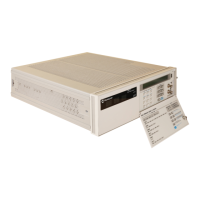Chapter 3 In Case of Difficulty
Operating System Failure
Operating and Programming Manual 37
Operating System Failure
This section provides information to check symptoms associated with operating
system failures and a procedure to restart the 5071A in the event of such a failure.
Operating System Failure Symptoms
Five symptoms are associated with operating system failure:
• Continuous Operation light extinguished: The front-panel Continuous
Operation light is out and does not light with attempts to reset continuous
operation.
• Deteriorating Stability and Accuracy: Although the instrument‘s rear-
panel outputs are electrically active, the observed stability and accuracy are
out of specification with no frequency offsets present or output steering
active.
• Clock Stops: The large front-panel LED clock display and CLOCK menu
time display fail to show incrementing time.
• Unresponsive Front-Panel: Attempts to issue commands from the front-
panel keys fail to cause any LCD display update or changes to the
instrument‘s rear-panel output functions. Refer to the restart procedure.
• Unresponsive Rear-Panel RS-232C Serial Port: Attempts to issue
commands through a correctly configured rear-panel RS-232C serial port fail
to cause any remote terminal display update and/or changes to the
instrument‘s rear-panel output functions. Refer to the restart procedure.
Restarting the 5071A
Check all configuration and operating commands issued from the front-panel or
through the RS-232C-serial port immediately prior to the operating system
failure. Attempt to determine if the failure occurred in association with any
recent changes in the instrument‘s environment or power source.
Use the following procedure to restart the 5071A in the event of an operating
system failure.
1 Remove external-dc power (if connected).
2 Remove ac-line power.
3 Disable the internal battery by operating the rear-panel battery-disconnect switch.
(Refer to ―Disabling the Internal Standby Battery‖ on page 28 for details). (Note:
this does not apply for 48V option).
4 Re-apply ac-line power.
5 Observe the instrument for successful completion of the normal power-up and
warm-up sequence.

